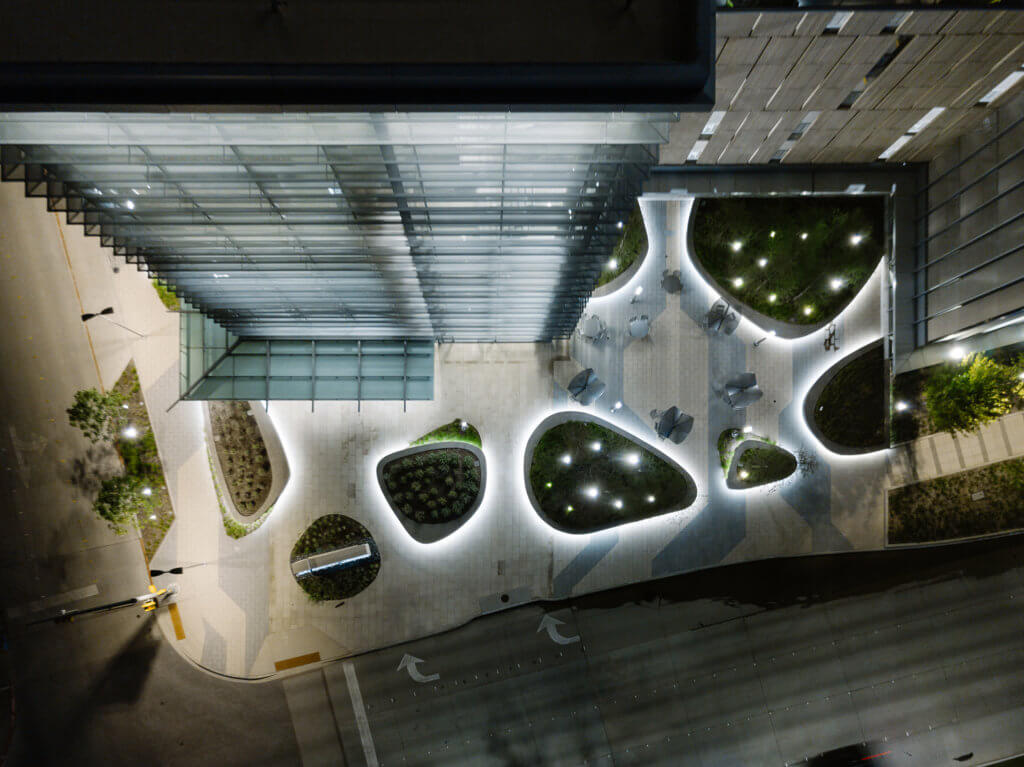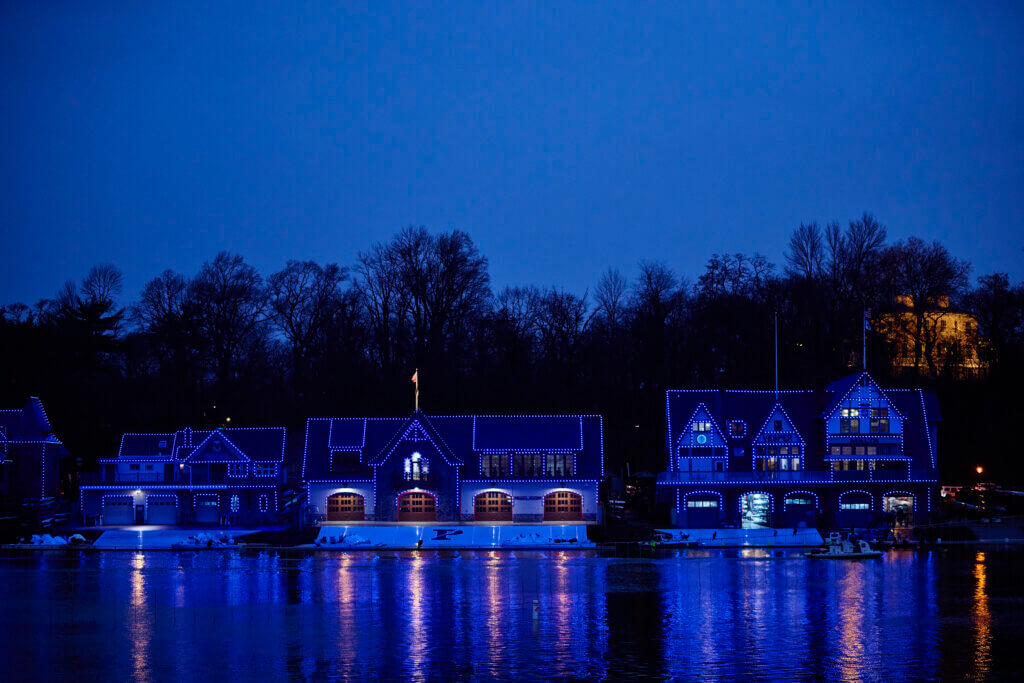Welcome to the warm embrace of Summer! As the temperature rises, indoor spaces extend into the outdoors and many welcome the opportunity to spend more time outside. Outdoor lighting provides function and aesthetics, guiding pedestrians along a path, offering security on a dimly lit trail, highlighting architectural elements, and casting a gentle glow on trees.
With the continual evolution of lighting, it has revolutionized outdoor spaces, providing an all-new artistic and nuanced approach to landscape and exterior lighting.
The Lighting Practice (TLP) Principal, Jered Widmer, offers six ways you can elevate an exterior environment with lighting.
1. Lighting Effects

Liberty Mutual, Plano, TX – Photo provided courtesy of OMNIPLAN
Exterior illumination can reveal textures, shapes, and depth without revealing the light fixtures. Integrating luminaires into benches, planter walls, shade canopies, and trees can create mesmerizing and magical environments without sacrificing safety and security. Careful coordination between the lighting designer, architect, and landscape architect during design can flesh out intriguing integrated solutions that are durable and maintainable. When done right, integrated lighting can create an ethereal outdoor experience.
“Lighting should complement the design and not stand out as an afterthought”, advises Jered.
2. Light Verticals and Perimeters

Thomas Jefferson University- Dorrance H. Hamilton Building, Philadelphia, PA – Photo by Jeffery Totaro
A simple but often forgotten approach to lighting the exterior environment is the accent of verticals and perimeters. By considering the viewer’s sightlines and how they move through the space, it can influence where to apply light. This technique is particularly useful in unsecure, public spaces where safety is important or to aid wayfinding.
“Light levels on the ground aren’t the only way to make a space feel inviting” explains Jered, “lighting verticals and perimeters can provide a sense of safety and define the space.”
Casting soft light into corners and splashing some light onto green screens and trellises can reduce extreme darkness and create texture.
3. Dimming

Pentagon Row, Arlington VA – Photo by HB Field & Studio
Incorporating dimmable lighting elements not only mitigates glare and brightness but also enhances aesthetics for various occasions while reducing energy consumption. This versatility allows for the creation of a balanced outdoor environment, catering to diverse needs and preferences.
“By zoning and dimming specific light fixtures, you can strike a better balance in an outdoor lighting environment”, says Jered. “We see the programming for outdoor spaces vary based on season and day of the week. Dimming provides more flexibility for the use of these spaces”.
Whether creating an intimate gathering space or highlighting architectural features, dimmable lighting provides adaptable outdoor settings, promoting practicality, visual appeal, and sustainability.
4. Moonlighting

The Domain, Austin, TX – Photo by Paul Bardagjy
Moonlighting is a technique that mimics the natural glow of the moonlight, adding a soft touch to an outdoor space.
“This strategy creatively reduces the need for light poles or bollards, providing a layer of illumination for wayfinding and safety”, says Jered.
The fixtures are typically placed 20-25 feet up in a tree and cast a gentle illumination through the tree branches.
“This technique can be applied effectively with a variety of trees and foliage”, says Jered. “When applied in palms and other single trunk species, metal gobos can be used to replicate patterns and shadows”.
5. Integrating Color-Changing Elements

Boathouse Row, Philadelphia, PA – Photo by Albert Lee for Fairmount Park Conservancy
Integration of color-changing light on a project can be done for many reasons. Most commonly, colored light is used to communicate a message and connect with the community.
“Many clients want exterior lighting on their project that can be used to celebrate holidays or recognize local sports teams and schools,” says Jered. “We work with the team and owner to find creative and harmonious ways to integrate color-changing lighting.”
An important consideration when implementing colored light is the ability of the final solution to revert to a simple white light output. With newer technology that uses RGBW (color and white LEDs), this is easily accomplished and can provide a more viable long-term solution for the client.
6. Catenary Lighting

Bethesda Row, Bethesda, MD – Photo by Tara Dilenge, The Lighting Practice
Catenary lighting refers to overhead lighting suspended by cables that are anchored to walls or poles. This technique opens up the space by eliminating potential light poles, providing more flexibility for programming. It also offers a unique opportunity to introduce decorative luminaires to support the desired aesthetic. Although festoon lighting will always be a popular choice for making outdoor spaces feel warm and intimate, Jered highly suggests catenary lighting.
“If you’re looking for a unique strategy that can add more character into the space and stand out from the crowd, catenary is a different approach to overhead lighting,” says Jered.
Embrace outdoor environments this summer by applying these lighting techniques, providing function and visual interest to all spaces. In order to achieve the design goals of the space, it is crucial for the lighting designer to work closely with the landscape architect and design team. Two challenges for designing exterior environments are strict energy codes and new city ordinances. A lighting designer can achieve the desired aesthetic of an outdoor space, while also mitigating technical constraints and challenges.
Now more than ever, exterior environments can be designed more creatively, because of advances in technology and the desire to make outdoor spaces transformative. Lighting elevates and compliments the landscape and architects’ visions, making outdoor spaces memorable and enjoyable.





